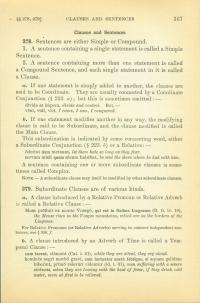278. Sentences are either simple or compound.
- A sentence containing a single statement is called a Simple Sentence.
- A sentence containing more than one statement is called a Compound Sentence, and each single statement in it is called a clause.
a. If one statement is simply added to another, the clauses are said to be Coordinate. They are usually connected by a Coordinate Conjunction (§ 223.a); but, this is sometimes omitted.
dīvide et imperā divide and control
BUT
Vēnī, vīdī, vīcī. I came, I saw, I conquered.
b. If one statement modifies another in any way, the modifying clause is said to be Subordinate, and the clause modified is called the Main Clause. This subordination is indicated by some connecting word, either a Subordinate Conjunction (§ 223.b) or a Relative.
Ōderint dum metuant.
Let them hate so long as they fear.
Servum mīsit quem sēcum habēbat.
He sent the slave whom he had with him.
A sentence containing one or more subordinate clauses is sometimes called Complex.
Note— A subordinate clause may itself be modified by other subordinate clauses.
279. Subordinate clauses are of various kinds.
a. A clause introduced by a Relative Pronoun or Relative Adverb is called a Relative Clause.
Mosa prōfluit ex monte Vosegō, quī est in fīnibus Lingonum. (B. G. 4.10)
The Meuse rises in the Vosges mountains, which are on the borders of the Lingones.
For Relative Pronouns (or Relative Adverbs) serving to connect independent sentences, see § 308.f.
b. A clause introduced by an Adverb of Time is called a Temporal Clause.
Cum tacent, clāmant ( Cat. 1.21)
While they are silent, they cry aloud.
Hominēs aegrī morbō gravī, cum iactantur aestū febrīque, sī aquam gelidam biberint, prīmō relevārī videntur (id.1.31)
Men suffering with a severe sickness, when they are tossing with the heat of fever, if they drink cold water, seem at first to be relieved.
c. A clause containing a Condition, introduced by sī (if, or some equivalent expression), is called a Conditional Clause. A sentence containing a conditional clause is called a Conditional Sentence.
Thus, sī aquam gelidam biberint, prīmō relevārī videntur (in b, above) is a Conditional Sentence, and sī . . . biberint is a Conditional Clause.
d. A clause expressing the Purpose of an action is called a Final Clause.
edō ut vīvam.
I eat to live (that I may live).
mīsit lēgātōs quī dīcerent
he sent ambassadors to say (who should say)
e. A clause expressing the Result of an action is called a Consecutive Clause.1
Tam longē aberam ut nōn vidērem.
I was too far away to see (so far away that I did not see).


